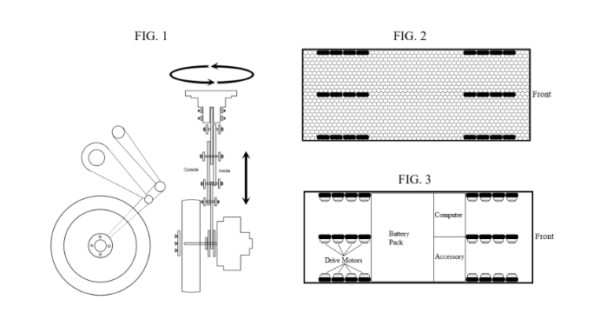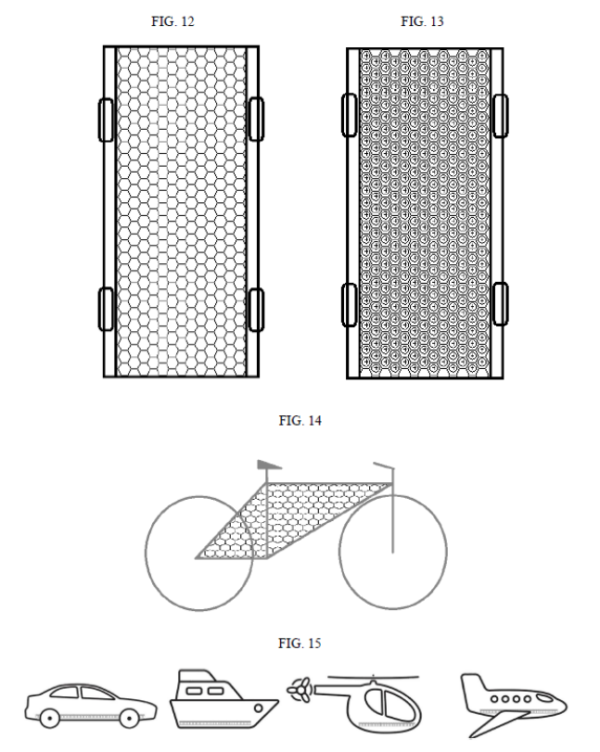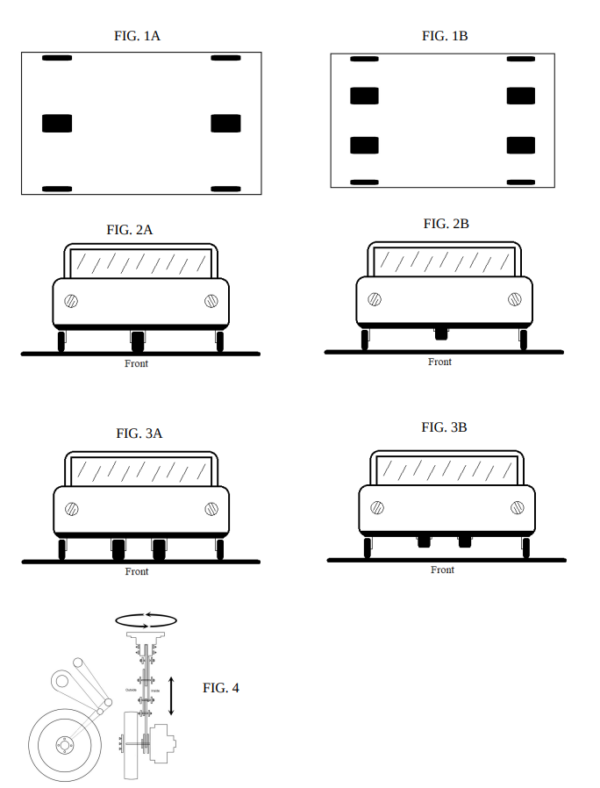Electric Vehicles are increasing in popularity with their economic and eco-friendly features. Although they are great vehicles there are some flaws. In the following you will be able to see solutions to these problems and what new features could be implied to make
Click to Jump to:
Lightweight Honeycomb Structural Battery Pack
EV Driveline
Electric Vehicle Powertrain
One of the greatest struggles with electric vehicles is the amount of time required to recharge the batteries. We find that a full recharge takes about 12 hours and a solution to this would be to change the battery for a faster recharge time. This new powertrain solves the issue. With this powertrain, the user can transfer their cabin of choice to a fully charged powertrain in a matter of minutes.
Each side of the car will have at least two wheels that will be powered independently by electric motors. The electric motors can be mounted wherever they are needed. Optionally, there can be a third set of wheels in the center of the car for additional friction to begin moving the car and then become the primary wheels used when the vehicle is traveling at higher speeds while the outer wheels are retracted to reduce friction. Each set of wheels can be inline with each other or can be offset to prevent wear on the roadway and each wheel can be adjusted. This allows the on-board computer to raise and lower each wheel independently to ensure optimal friction with the ground at any time. Each wheel can pivot 90 degrees in either direction to aid with braking or even parallel parking. The differential system will be controlled by the on-board computer with sensors in the steering wheel and/or in the wheels to sense the additional friction and adjust accordingly. The anti-lock braking system uses similar sensors to determine where the braking is needed the most.
This new driveline will allow the electric car to create much less drag and increase braking power. There can be at least two wheels on each side of the vehicle. It can have an optional set of at least two wheels in the center of the vehicle. The set of wheels in the center will allow the car to have much more braking power but also increase friction to the ground, making acceleration much more efficient. The set of wheels in the center of the vehicle will become the primary set whenever reaching higher speeds. The sets of wheels on the left and right will retract slightly so the wheels in the center are the only contact with the ground.
The new electric car driveline ultimately is designed to make electric cars increasingly more efficient. Optionally, there can be a third set of wheels in the center of the vehicle. This third set of wheels will provide additional traction for improved acceleration and braking power. The third set of wheels, in the center, will become the primary set of wheels when cruising speed is reached. The sets of wheels on each side will retract, leaving only the center set in contact with the ground. At least one electronic gyroscope can maintain stabilization when only using the center set of wheels. This will greatly reduce the resistance against the vehicle.

Lightweight Honeycomb Structural Battery Pack
The premise of this invention is to simplify and improve the previous methods used for battery systems in any vehicle that relies on battery power. This new method uses a honeycomb structure, in either hexagonal, circular, rectangular, or even ovular grids. Each of these grids will house each individual battery cell. This battery pack can be used for structural purposes of the car. This could replace the chassis or become part of it. The structural battery pack can be in beam-like segments to run from one end of the vehicle to the other, either side to side or front to back. The beam-like battery pack can be diagonal if necessary. The honeycomb grid itself can be made of metal, polymer, paper, wood veneer/products, or fiberglass.
The complete modular battery pack, with cells inserted, can be easily placed in a group. The top and bottom plates, positive and negative connectors, can be pre-wired for easy installation and the case will become part of the integral structure. The interconnected housings and honeycomb grid will be water-tight to allow the air or coolant to pass without creating a short-circuit or other issues. Modular battery packs have battery cells with casings which function as the sandwich core grids or you can have a flange connect each casing forming the honeycomb grid. Each flange has a hole for air or coolant to pass through for core temperature control. The combination of flange and casing will become the newest technology, the casing of the battery will form the honeycomb grid. This invention will make battery cells become lighter in weight by functioning as the sandwich structural core. It will also simplify production. Instead of making individual batteries, you can insert the core of the battery cells into the honeycomb grid, which becomes the battery casing. It will have at least one layer of sandwiched skin on both sides. The most strength will be provided by gluing. By itself, the grid is a lightweight honeycomb structure. By adding multiple battery packs, it will glue together with at least one layer of skin on each side for weather protection and strongest strength with minimum weight; due to the honeycomb grid structure and battery casing connected to form an enclosed sandwich grid without additional weight.
The grid can be integrated with the battery cells to make one large modular battery pack. The cells in the pack can run parallel, for increased amperage, and/or series, for increased voltage, and use conductive plates to connect each cell in the pack. The battery pack will become a honeycomb type structure, but the grid shape can be hexagonal, circular, rectangular, or square. Each battery pack can be a separate unit from the honeycomb panel, they are glued into place with skin material on each side. Multiple battery packs can be joined by adhesion and/or mechanical fasteners and at least one large skin on either side, in one large panel or post and beam. The honeycomb structure will act as an insulator for the individual battery cells. If battery cells are integrated with the honeycomb grid, then the grid will become the negative connection. The positive connection will be isolated from the negative connection, which can be the grid itself or a plate. This structure, complete with all battery cells, will be a modular block that can be easily removed or replaced by removing the entire adhered skin and mechanical fasteners, if used. The modular block cell housing can be used for the structure of the vehicle. The housing can span across the entire floor pan of the vehicle or can be in beam-like sections. The beam-like sections may provide structural support and can span from side to side, front to back or diagonally across the undercarriage of the vehicle. Each block of parallel battery cells will be connected in series to each other, increasing the overall voltage. In doing so, the parallel cell block will be easily interchangeable in the series, instead of every battery cell individually. The battery cell housings will be interconnected and waterproof. This allows air or coolant to pass easily through without creating a short-circuit. This will provide cooling on all sides of each battery cell. In conclusion this invention is to simplify and improve the previous methods used for battery systems in any vehicle that relies on battery power.


EV Driveline
This invention is designed to improve the efficiency of modern electric vehicles. This electric vehicle driveline will increase the range an electric vehicle can travel per charge. The new EV driveline consists of narrow and/or smaller diameter wheels that will greatly reduce drag while driving at cruising speeds. Layout of said wheels will be similar to current vehicles, with wheels on each corner of the vehicle, but can have an extra wheel placed between the front and/or back sets of wheels or possibly in the center of the vehicle.
Extra wheels provide additional friction for gaining speed as well as additional braking power. The number of wheels in the driveline will depend on the user’s desired acceleration and/or deceleration rate. The extra wheels can be wider, to provide additional friction, or thinner for less drag. Each wheel’s suspension will be able to raise and lower independently to accommodate for uneven terrain. This will also keep the chassis of the vehicle level no matter how uneven the terrain is. The driveline will use a regenerative braking system to store additional energy, providing additional range. The electric motor will act as a generator whenever not consuming power. That means that every time the car is coasting down a hill or coming to a stop, the motor will become a generator and feed additional energy to the energy storage.
The premise of this invention is to limit the amount of drag acting upon the vehicle while in motion. In doing so, the energy consumption will be much more efficient and provide more available energy per refueling. This means that there will be much more range available from one charge cycle.

